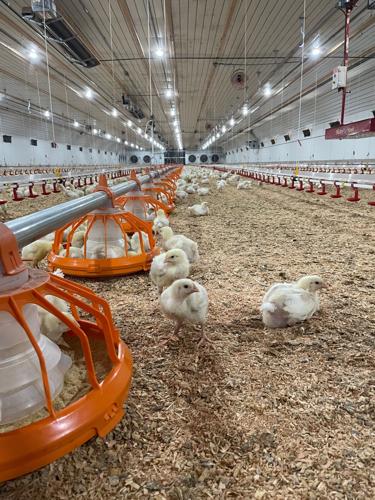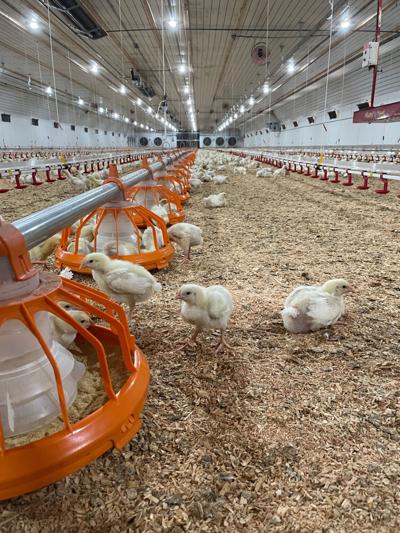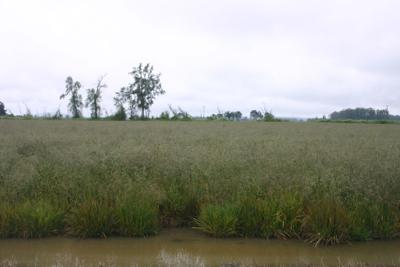SCIO, Ore. — A steady mid-June rain fell as Christina Eastman drove her UTV past fields of grass and yellow-flowering dill at her family’s farm outside Scio, Ore.
Eastman stopped along the North Santiam River near Wiseman Island, a reach known for providing high-quality fish and wildlife habitat. From here, the river flows past an adjacent property that could soon be home to millions of chickens raised every year for the poultry company Foster Farms.

Christina Eastman, a member of the Farmers Against Foster Farms group, stands next to her pickup truck at her family’s farm near Scio, Ore.
The operation, J-S Ranch, is one of three new large-scale chicken farms proposed in the Mid-Willamette Valley. Members of the industry say the farms are needed to make up for lost production as more growers have retired in recent years, and to keep up with Americans’ appetite for chicken.
However, the proposals have neighbors like Eastman worried about potential impacts, including air and water pollution, odor and increased traffic on the rural roads.
“They couldn’t pick a worse place than here,” Eastman said. “It’s going to affect our farming, it’s going to affect our crops, it’s going to affect our way of life.”
Eastman is part of a group called Farmers Against Foster Farms, which opposes the three farms and has appealed to state regulators and lawmakers for greater protections.

A view of where J-S Ranch will be built near Scio, Ore. The operation will house up to 580,000 chickens at a time once it is completed.
J-S Ranch has already received permits to begin construction. The other two — one near the small community of Jordan and another between the cities of Stayton and Aumsville — are still in the process of obtaining permits.
Eric Simon, a longtime poultry farmer from Brownsville, Ore., will own and manage J-S Ranch. He said newer facilities are equipped with modern technology and state-of-the-art ventilation systems that minimize impacts like odor, while providing the perfect environment for chickens.
Barns are cleaned and disinfected between each flock, and manure is sold as nutrient-rich fertilizer.
“Frankly, we’ve been operating these businesses for 30 years out here, and we haven’t done harm to the area,” Simon said. “So the proof is out there.”
Three farms
It has taken Simon nearly two years from when he bought the property in 2020 to receive his permit for a confined animal feeding operation, or CAFO, for J-S Ranch.

Eric Simon, a longtime chicken farmer, will operate the J-S Ranch near Scio, Ore. He and others in the poultry industry say new technology for the farms is tailored for animal welfare, while controlling odor. Simon is pictured here at Hiday Poultry Farms LLC in Brownsville.
The permit was issued May 26 by the Oregon Department of Agriculture and Department of Environmental Quality, which jointly manage the state’s CAFO program. J-S Ranch will include 11 barns, each measuring 39,120 square feet, where Simon will raise six flocks of up to 580,000 chickens per year, totaling 3.48 million birds.
No chickens will be slaughtered on site. Instead, they will be sent to Foster Farms’ processing plant in Kelso, Wash.
Farmers Against Foster Farms, along with seven other groups that oppose the project, petitioned ODA and DEQ in June to reconsider the permit, saying it does not do enough to protect water and wells from possible contamination.
The agencies denied the petitioners’ request for a temporary stay, finding they did not show they would suffer irreparable harm.
Simon said he has not yet broken ground, but hopes to later this summer.
Meanwhile, the owners of the two other proposed large-scale chicken farms are still seeking permits.
Jason Peters submitted a CAFO application for Evergreen Ranch on May 22, which would allow him to construct 16 barns each measuring 60-by-600 feet. Here, he would raise six flocks of up to 750,000 chickens annually, or 4.5 million birds.
Evergreen Ranch would be near Thomas Creek, roughly 8 miles east of Scio and within a half-mile of the Lourdes Public Charter School in Jordan.

A view of the proposed Evergreen Ranch site near Jordan, Ore., and Thomas Creek.
Meanwhile, Hiday Poultry Farms LLC has purchased an 86-acre property between Stayton and Aumsville in Marion County. The other two farms are in Linn County.
Owner Randy Hiday currently raises 530,000 chickens per flock for Foster Farms in the Brownsville area, 40 miles to the south.
Neighbors concerned
Teresa Clausen, a neighbor whose home is across a small irrigation ditch from where Hiday plans to expand, said she first learned about the proposal in 2019.
At the time, Clausen was working at a store where she met a man who was a land scout for Foster Farms. He told her about the company’s plans, which Clausen said came as a shock.
“I was fighting back tears, and my adrenaline was rushing,” she said. “Now slowly, over the last two years, all of it is coming to fruition.”
Until then, Clausen said she had no idea the region was being considered for more large chicken farms. She contacted Kendra Kimbirauskas, a small-scale rancher in Scio, to learn more about the proposals.
While Clausen said she believes in the right to farm, she worries such a large operation next door might contaminate her home’s well and foul the air with poultry dust and ammonia.
“It will affect the community,” she believes. “Not just the people who live in proximity to it, but the entirety of it.”
Kimbirauskas is one of the core organizers of Farmers Against Foster Farms, and has 20 years of experience advocating for sustainable agriculture and food systems.
“Neither our land use laws, nor our water laws, nor our air laws are currently at a level that’s effective at mitigating (these) impacts,” she said. “I think Oregon is about 15 to 20 years behind the rest of the country, in the sense of how industrial animal agriculture has expanded.”
Water quality
A major point of contention is how the chicken farms might impact surface water and groundwater.

The North Santiam River flows past Eastman Farms near Scio, Ore., winding toward the proposed J-S Ranch. Opponents of the project worry pollutants from the chicken farm will contaminate the river, harming salmon habitat.
Opponents have argued the local water table rises above surface level during the rainy winter months, increasing the likelihood that pollutants from chicken manure could seep underground or wash into creeks and rivers.
“This place is just too wet in the winter,” Eastman said. “The water will come straight up, and all that bird feces, ammonia and urine is going to be pulled right down into the ground.”
However, Bill Mattos, president of the Northwest Chicken Council, said farms are built and managed in such a way to prevent that from happening.
“There’s never been a discharge of poultry product into a stream in Oregon. It’s just never happened,” Mattos said.
Chicken barns do not have concrete floors, but instead have compacted soil topped with 6-8 inches of dry wood shavings. Used litter is stored in separate facilities that do have a concrete floor, and is kept only until it can be sold for fertilizer.
“The idea that the manure is going to lie around, it’s just not going to happen,” Mattos said. “It’s gone as soon as they can get it shipped.”
As added conditions of the permit issued to J-S Ranch, Simon must complete a ground compaction study before any chickens arrive and monitor each of two static wells to ensure groundwater remains at least 2 feet below the floors.
Still, some residents say they are not reassured.
Linda Duman, administrator of the Lourdes Public Charter School in Jordan, worries the potential of airborne ammonia and increased groundwater nitrates from the proposed Evergreen Ranch could cause health problems in her students. The school enrolls up to 49 kids, grades K-8.

Linda Duman is the administrator for Lourdes Public Charter School in Jordan, Ore., near the proposed Evergreen Ranch site that would raise approximately 4.5 million broiler chickens annually for Foster Farms. Duman said she is concerned about how the operation will affect air and water quality in the community.
“It really hits children and older people,” Duman said. “I would think we put some common sense and critical thinking into this.”
Need for expansion
Expansion is already underway at Hiday Poultry Farms’ Nye Road Ranch in Brownsville, a densely agricultural area surrounded by grass seed fields, hazelnut trees and sheep ranches.
Randy Hiday began raising chickens nearly 30 years ago, starting out at two small farms in neighboring Lane County. He bought the operation from Foster Farms in 2005, starting with eight barns and building five more.
Now, seven additional barns are under construction as Hiday said the need for expansion has grown.
“When I started, we had about 105 to 110 farms in the Northwest. We have 26 left,” he said. “I know we’re 5 million birds short, probably, of where we need to be.”
According to the Northwest Chicken Council, Oregon has 26 growers with 151 barns totaling 3.17 million square feet, raising more than 25 million chickens per year. All of that production is in the Willamette Valley.
Rich Reid, live production manager for Foster Farms based in Aurora, Ore., estimated the company has lost 500,000 square feet of barn space in the last five years to grower retirements, and expects to lose 1.2 million square feet in the next five years.
”All of that growing space we’re trying to replace to continue to be sustainable,” Reid said.
Mattos said Americans eat more chicken than any other protein, and local production is needed to satisfy increasing demand.
Inside the barns
During a tour of one of the Hiday barns near Brownsville, Mattos and representatives of Foster Farms showed how automated technology creates an ideal indoor environment for thousands of baby chicks. They all donned Tyvek suits for biosecurity.

An aerial view of Hiday Poultry Farms LLC in Brownsville, Ore.
”This is what keeps the birds happy,” Reid said, pointing to a control panel that continuously monitors temperature, humidity and ammonia levels that meet American Humane Farm Program guidelines. “This is the brain.”
According to a publication from the University of Georgia Cooperative Extension, though smells associated with any type of livestock farm are inevitable, advancements in ventilation and drinking systems help keep poultry barns dry, which in turn helps to control odor.
“Properly operated poultry houses emit minimal odor,” the publication states. “In fact, it is not unusual to approach a modern, well managed poultry house without experiencing any or only minimal odors. The drier conditions in the houses also ensure little or no fly production associated with growing chickens.”
Air from inside these barns is circulated to keep chickens cool, and emitted from exhaust fans. The exhaust extends about 50 feet before it is dispersed into the atmosphere.

Baby chicks in a barn at Hiday Poultry Farms LLC in Brownsville, Ore. The operation raises 530,000 broiler chickens per flock for Foster Farms.
The publication, written by Dan Cunningham, the university’s extension coordinator for poultry science, recommends providing “reasonable” setbacks from property lines and dwellings to ensure neighbors are not adversely impacted.
Both Hiday and Simon said they have never received complaints about their farms from neighbors.
Jason Gentemann, Pacific Northwest Division manager for Foster Farms, said the modern facilities adopted by Hiday and Simon are evidence of their commitment to animal welfare, while simultaneously minimizing impacts such as odor.
”Somebody’s gotta grow chickens to be able to feed people in the state of Oregon,” Gentemann said. “They do it the right way.”
Working group
The issue has garnered attention from the Oregon Senate, which has convened a working group to further examine the impact of large poultry farms.

A sign near Aumsville, Ore. opposing new chicken farms that would raise birds for Foster Farms.
Sen. Michael Dembrow, a Portland-area Democrat, is leading the 21-member group, which includes members from Farmers Against Foster Farms and other environmental groups, industry representatives and staff members from ODA, DEQ, the Oregon Water Resources Department and Department of Land Conservation and Development.
The group met twice in July, and will meet again Aug. 12 and 31 and Sept. 15. Dembrow said it is still too early to tell what — if any — proposals may be brought back to the full Senate Committee on Natural Resources and Wildfire Recovery.
Kimbirauskas, with Farmers Against Foster Farms, said the group needs to examine Oregon’s land use laws to determine whether massive chicken barns should be allowed on high-value farmland, and whether Oregon’s CAFO program should regulate air quality in addition to water quality.
She said the farms also take advantage of the state’s livestock watering exemption, which exempts livestock from water rights permits without restriction.
“We’re really trying to make our rural area a place where people want to live and have a vibrant life,” she said, “and not just have it be a sacrificed zone for these corporations to take our wealth and send it elsewhere.”
What is happening now may be just the tip of the iceberg, Kimbirauskas said. Foster Farms was acquired in June by Atlas Holdings, a Connecticut-based investment firm, for an undisclosed amount.
“One thing we do know is that companies don’t acquire other companies to maintain the status quo,” she said.
Depending on the work group’s findings, Dembrow said it is possible the state will need to come up with a new strategy to mitigate the impact of poultry farms.
“I think there’s concern,” he said. “(Opponents) are really focused on Oregon not becoming such a ‘chickenville.’ I sympathize with that. If that’s what we’re facing, that is problematic.”
George Plaven is a reporter for the Capital Press.













(0) comments
Welcome to the discussion.
Log In
Keep it Clean. Please avoid obscene, vulgar, lewd, racist or sexually-oriented language.
PLEASE TURN OFF YOUR CAPS LOCK.
Don't Threaten. Threats of harming another person will not be tolerated.
Be Truthful. Don't knowingly lie about anyone or anything.
Be Nice. No racism, sexism or any sort of -ism that is degrading to another person.
Be Proactive. Use the 'Report' link on each comment to let us know of abusive posts.
Share with Us. We'd love to hear eyewitness accounts, the history behind an article.